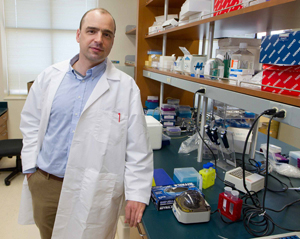New insights about personal genomes will give pathologists and clinical laboratory scientists different ways to use genetic tests in the screening, diagnosis, and treatment of disease
Here is a human genome curve ball for pathologists and clinical laboratory scientists engaged in genetic testing in their medical laboratories. New research indicates that a larger number of humans than was once believed may have more than one genome. This has implications for many medical and health issues.
Until recently, scientists assumed that, as a rule, each individual had a unique genome. Conditions such as mosaicism and chimerism were considered a rarity.
Greater Incidence of Multiple Genomes in a Single Individual
Now, however, different research studies are producing data that indicate a large proportion of humans may have more than one genome. This research has been enabled by advancements in both gene sequencing technology and the capabilities in computational and analytical software.
Chromosomal mosaicism exists when an individual has two or more cell populations with a different chromosomal makeup, according to the National Institutes of Health website. In cellular chimerism, two or more cell populations of different chromosomal constitutions—that are derived from different individuals—occur in a single individual.
Gene Sequencing of Larger Numbers of Patients
“[T]hree years ago, suggesting that there was widespread genetic variation in a single body would have been met with skepticism,” observed Alexander E. Urban, Ph. D., Assistant Professor of Psychiatry and Behavioral Sciences and, by courtesy, of Genetics at Stanford University School of Medicine. Urban’s comments appeared in a story published in The New York Times. “Rather than monoliths, our bodies may be mosaics composed of cells whose genomes differ,” Urban declared.

Alexander Urban, Ph. D. (pictured above), Assistant Professor of Psychiatry and Behavioral Sciences and, by courtesy, of Genetics at Stanford University School of Medicine and his colleagues are among researchers now using gene sequencing to investigate multiple personal genomes in single individuals. Their findings show that more than one genome is more common than once thought. This could have significant implications for the practice of medicine, including diagnostic medicine. (Photo by Norbert von der Groeben and copyright Stanford University.)
With the cost of gene sequencing falling steadily, more patients are having their entire genomes sequenced. With this increase in data, scientists are finding a connection between multiple genomes and certain rare diseases, according to the Times story. These scientistsy are now beginning to investigate genetic variations for possible links to more common disorders.
“It’s changed the way we think,” noted James R. Lupski, M.D., Ph. D., Cullen Endowed Chair in Molecular Genetics and Professor of Molecular and Human Genetics at Baylor College of Medicine. Lupski made these comments in a recent review in the journal Science. According to Lupski, the existence of multiple genomes in an individual could have a tremendous impact on the practice of medicine.
Huge Amount of Cell-to-cell Genetic Variation May Be Common
Stanford University School of Medicine and Yale University recently conducted a study of changes in induced-pluripotent stem cells (iPSC), according to the Stanford University website. Urban was a senior author of a study, which was published in the November 18, 2012, issue of the journal Nature.
Urban and his colleagues investigated mutations in fibroblasts from seven volunteers. From these cells, they generated 20 different iPSC lines. They searched specifically for copy number variations (CNV). CNVs indicate the disappearance or duplication of sections of genetic material at specific locations along the vast stretches of DNA. The findings showed that 30% of the fibroblasts carried at least one CNV, according to the Times piece. “This is a huge amount of cell-to-cell genetic variation,” observed Urban.
Genetic Test Results May Need to be Interpreted Differently
Genetic testing is based on the assumption that humans have a single genome, the Times writer noted. Previously, scientists believed that the genome from cells taken in a cheek swab, for example, would reveal genetic information about cells throughout the body.
The Times article also cited other studies and investigations that are upending long-held beliefs about unique individual genomic identity.
In one study, researchers at Innsbruck Medical University in Austria took cheek swabs from 77 bone marrow transplant recipients. They found a mix of genomes—the recipient’s own and the donor’s—in 74% of the samples. The transplanted stem cells had not just replaced blood cells. They had also become cells lining the cheek.
Multiple Personal Genomes May Change Work of Forensic Scientists
Multiple personal genomes also potentially impact the work of forensic scientists. They use DNA matching to identify criminals or murder victims. Multiple genomes in one person could prove misleading in the identification process. For example last year forensic scientists at the Washington State Patrol Crime Laboratory found non-matching genomes in saliva and sperm samples from the same suspect in a sexual assault case.
Multiple genomes could also have serious implications for genetic counselors, the Times pointed out. For example, a DNA test that uses blood cells could miss disease-causing mutations in the cells of other organs. “We can’t tell what else is going on,” stated Nancy B. Spinner, Ph.D., Director of the Clinical CytoGenomics Laboratory and Professor of Pathology and Genetics at the University of Pennsylvania’s Perelman School of Medicine, in a review published in the May issue of Nature Reviews Genetics.
As researchers make further progress in their understanding about the incidence of individuals with one or more genomes, this new knowledge is likely to reshape how genetic testing is performed and interpreted. For pathologists and clinical laboratory scientists, this new knowledge further complicates how genetic testing is used for diagnostic and therapeutic purposes.
—Pamela Scherer McLeod
Related Information:
Study finds a patchwork of genetic variation in the brain
Interview: Prof. Jim Lupski – Genome sequencing
Genome Mosaicism—One Human, Multiple Genomes
Somatic copy number mosaicism in human skin revealed by induced pluripotent stem cells



